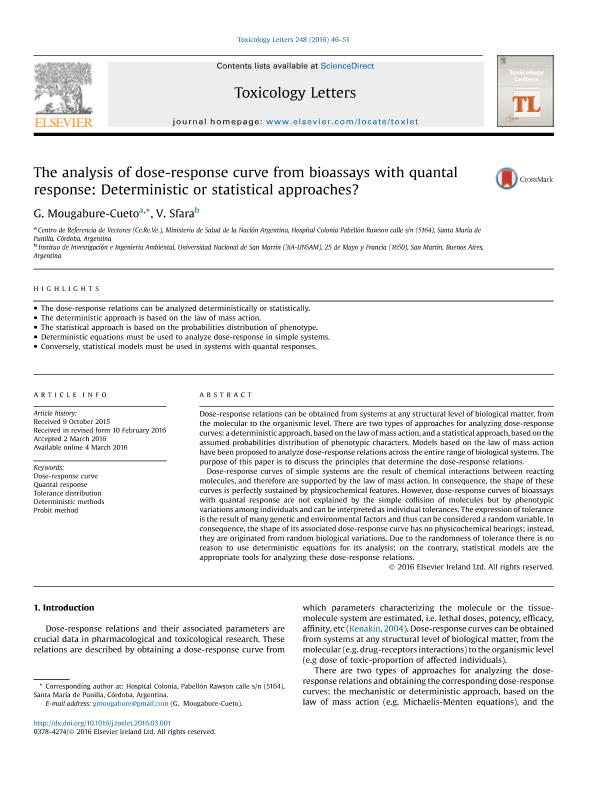Mostrar el registro sencillo del ítem
dc.contributor.author
Mougabure Cueto, Gastón Adolfo

dc.contributor.author
Sfara, Valeria

dc.date.available
2018-04-27T19:39:20Z
dc.date.issued
2016-04
dc.identifier.citation
Mougabure Cueto, Gastón Adolfo; Sfara, Valeria; The analysis of dose-response curve from bioassays with quantal response: Deterministic or statistical approaches?; Elsevier Ireland; Toxicology Letters; 248; 4-2016; 46-51
dc.identifier.issn
0378-4274
dc.identifier.uri
http://hdl.handle.net/11336/43740
dc.description.abstract
Dose-response relations can be obtained from systems at any structural level of biological matter, fromthe molecular to the organismic level. There are two types of approaches for analyzing dose-responsecurves: a deterministic approach, based on the law of mass action, and a statistical approach, based on theassumed probabilities distribution of phenotypic characters. Models based on the law of mass actionhave been proposed to analyze dose-response relations across the entire range of biological systems. Thepurpose of this paper is to discuss the principles that determine the dose-response relations.Dose-response curves of simple systems are the result of chemical interactions between reactingmolecules, and therefore are supported by the law of mass action. In consequence, the shape of thesecurves is perfectly sustained by physicochemical features. However, dose-response curves of bioassayswith quantal response are not explained by the simple collision of molecules but by phenotypicvariations among individuals and can be interpreted as individual tolerances. The expression of toleranceis the result of many genetic and environmental factors and thus can be considered a random variable. Inconsequence, the shape of its associated dose-response curve has no physicochemical bearings; instead,they are originated from random biological variations. Due to the randomness of tolerance there is noreason to use deterministic equations for its analysis; on the contrary, statistical models are theappropriate tools for analyzing these dose-response relations.
dc.format
application/pdf
dc.language.iso
eng
dc.publisher
Elsevier Ireland

dc.rights
info:eu-repo/semantics/openAccess
dc.rights.uri
https://creativecommons.org/licenses/by-nc-sa/2.5/ar/
dc.subject
Dose-Response Curve
dc.subject
Quantal Response
dc.subject
Tolerance Distribution
dc.subject
Deterministic Method
dc.subject.classification
Otras Ciencias Biológicas

dc.subject.classification
Ciencias Biológicas

dc.subject.classification
CIENCIAS NATURALES Y EXACTAS

dc.title
The analysis of dose-response curve from bioassays with quantal response: Deterministic or statistical approaches?
dc.type
info:eu-repo/semantics/article
dc.type
info:ar-repo/semantics/artículo
dc.type
info:eu-repo/semantics/publishedVersion
dc.date.updated
2018-04-27T14:00:50Z
dc.journal.volume
248
dc.journal.pagination
46-51
dc.journal.pais
Irlanda

dc.journal.ciudad
Amsterdam
dc.description.fil
Fil: Mougabure Cueto, Gastón Adolfo. Consejo Nacional de Investigaciones Científicas y Técnicas; Argentina. Ministerio de Salud de la Nación Argentina; Argentina
dc.description.fil
Fil: Sfara, Valeria. Consejo Nacional de Investigaciones Científicas y Técnicas; Argentina. Universidad Nacional de San Martín; Argentina
dc.journal.title
Toxicology Letters

dc.relation.alternativeid
info:eu-repo/semantics/altIdentifier/doi/https://dx.doi.org/10.1016/j.toxlet.2016.03.001
dc.relation.alternativeid
info:eu-repo/semantics/altIdentifier/url/https://www.sciencedirect.com/science/article/pii/S0378427416300376
Archivos asociados
